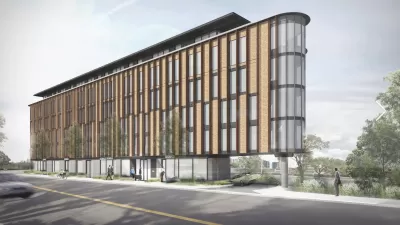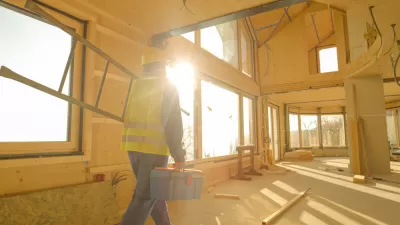Needing to expand to accommodate 35 million annual passengers by 2045 but constrained by Portland’s urban growth boundary, PDX had to think outside the box when planning its expansion. The result is a case study in sustainability.

The first phase of the nearly $2 billion expansion and renovation of Portland International Airport, commonly known as PDX, opened in August. It’s a novel project that has turned PDX into America’s largest mass-timber airport and, according to a recent article from Metropolis, represents a massive milestone for the mass-timber industry. It’s also an example of innovative, creative thinking to address a spate of challenges, including limited space for expansion because of the local urban growth boundary, lack of feasibility around building conjoining existing buildings, the need for seismic resilience against earthquakes, and the fact the existing terminal needed to stay operational during construction, and a desire for sustainability. The solution? Prefabricate a nine-acre wood roof at the edge of PDX’s grounds and slide it into place over top the existing, operational terminal.
“By choosing [a] rebuild over a new airport, the project reduced its carbon footprint by 70 percent, but this required complicated choreography,” Brian Libby, reports for Metropolis. The roof is made with 3.5 million board feet of Douglas Fir sourced from landowners and mills within a 300-mile radius of the airport. According to the article, “The just-completed first phase, built underneath [the timber roof], includes new check-in counters, a Market Hall lined with local businesses, enlarged security checkpoints, and a so-called ‘walk in the forest’: that includes 5,000 plants and 72 mature black walnut, ficus, and olive trees, courtesy of Portland landscape architecture studio PLACE. Phase 2, with passenger exit lanes, additional shopping-dining areas, and north-south views through walls of glass, opens in late 2025.”
FULL STORY: Forest to Frame: Why Portland’s Airport is a New Milestone for Mass Timber

Planetizen Federal Action Tracker
A weekly monitor of how Trump’s orders and actions are impacting planners and planning in America.

Congressman Proposes Bill to Rename DC Metro “Trump Train”
The Make Autorail Great Again Act would withhold federal funding to the system until the Washington Metropolitan Area Transit Authority (WMATA), rebrands as the Washington Metropolitan Authority for Greater Access (WMAGA).

The Simple Legislative Tool Transforming Vacant Downtowns
In California, Michigan and Georgia, an easy win is bringing dollars — and delight — back to city centers.

Albuquerque’s Microtransit: A Planner’s Answer to Food Access Gaps
New microtransit vans in Albuquerque aim to close food access gaps by linking low-income areas to grocery stores, cutting travel times by 30 percent and offering planners a scalable model for equity-focused transit.

This City Will Pay You to Meet Your Neighbors
A North Kansas City grant program offers up to $400 for residents to throw neighborhood block parties.

Commentary: Our Silence Will Not Protect Us
Keeping our heads down and our language inoffensive is not the right response to the times we’re in. Solidarity and courage is.
Urban Design for Planners 1: Software Tools
This six-course series explores essential urban design concepts using open source software and equips planners with the tools they need to participate fully in the urban design process.
Planning for Universal Design
Learn the tools for implementing Universal Design in planning regulations.
Smith Gee Studio
City of Charlotte
City of Camden Redevelopment Agency
City of Astoria
Transportation Research & Education Center (TREC) at Portland State University
US High Speed Rail Association
City of Camden Redevelopment Agency
Municipality of Princeton (NJ)





























